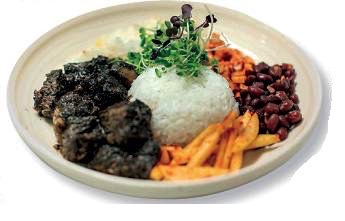North-East Indian cuisine
This is a collection of articles archived for the excellence of their content. |
Outlets outside the North-east
As in 2019
Anoothi Vishal, August 25, 2019: The Times of India

From: Anoothi Vishal, August 25, 2019: The Times of India
North-east food’s hot (we’re not talking about chillies)
Kolkata, the cosmopolitan melting pot of the east, has always been a gateway to the seven sisters. However, apart from Kalimpong-native Doma Wang’s coveted momos and a couple of small eateries serving food from Assam or Nagaland alongside Indian-Chinese, cuisine from the north-east has never really been represented adequately in the city that famously loves its food.
Now, that has changed. At the Grand Market Pavilion within the newly opened ITC Royal Bengal, the buffet has an extensive north-east section with dishes like kauri (Sikkimese handmade “pasta” served in a rich broth), Nagastyle pork cooked in black sesame paste, Manipuri ooti, Khasi jadoh, Assamese tenga, and tribal dishes made with local ingredients such as fiddlehead fern, culantro (a variety of cilantro called mandhonia in Assam), and even honey from stingless bees in Nagaland.
The menu didn’t happen overnight, with the hotel putting in several years of research into north-eastern culinary traditions and setting up a supply chain for sourcing authentic and often elusive ingredients. “The biggest stumbling block to setting up a north-eastern food restaurant on a large scale is sourcing the right ingredients. We have been able to overcome that by going to the region and establishing a proper supply chain,” says chef Vijay Malhotra of ITC Royal Bengal.
It is not just the big chains that are behind the transition of north-eastern food from niche to mainstream. In the metros, pop-up meals by home cooks and the mushrooming of small mom-and-pop restaurants have been giving people a taste for this cuisine.
In Delhi, for instance, last year saw the emergence of Bankaahi at Assam Bhawan run by restaurateur Utpala Mukherjee who sought to showcase not just better known Assamese dishes such as tenga or pitika but also dishes of the Brahmaputra Valley tribes such as mudru shamlai, a vegetarian stew of the Dimasas, kangthu or fish steamed in banana leaves of the Karbis, Aran, and a Mising-style pork cooked with Szechwan pepper leaves. “Most people only know a few popular dishes but my aim is to bring to the fore lesser-known dishes as well,” says Mukherjee. Then, a former Army major and his wife started Look Act East, a Manipuri restaurant in Dilli Haat.
In Mumbai, King Chilli, named after the world-famous hot “raja mircha”, became the talk of the foodie circuit for its Thangkul and Meitei tribal dishes apart from the other favourite Thotrin café offering Manipuri and Naga specials and home cook Gitika Saikia’s pop-ups.
Eat Your Kappa, a collection of vlogs on YouTube, has become quite a sensation. Run by Nambie Jessica Marak, a Shillong native who moved to Chennai, it celebrates her native Garo food while also documenting recipes. Kappa, interestingly, refers to a method of cooking, where a strong alkali extracted from bamboo is used to flavour and tenderise meats and vegetables.
These initiatives are not only making north-east dishes accessible, they’re also changing the perception that it’s alien. Due to the emphasis on preservation techniques such as fermentation, foraging of wild ingredients, minimal use of spicing, many Indians found it hard to acquire a taste for this cuisine. But with more millennials heading to the north-east for holidays and music festivals, there has been a great deal of cultural — and culinary — interest in the region in the last three-four years. As that interest goes from hole-in-the-wall eateries to five-star chains, the flavours of the north-east are enriching both palates and plates.